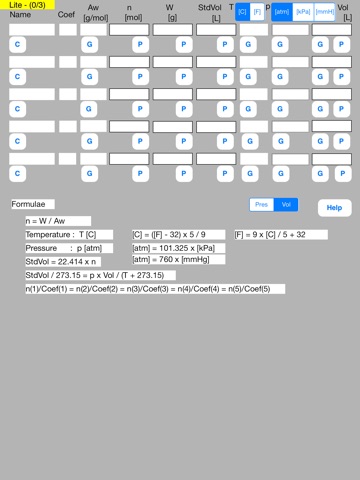
Mol calculator is a calculation sheet that solves chemical mol calculation problems.
Mol Calculator Lite is a Lite version of the Mol Calculator software. This can operate the P button up to 3 times. When 10 minutes pass and the software is resumed, the P button can be used again.
A typical problem is as follows.
(Example)
The hydrogen gas used for a fuel cell is generated from aluminum powder particles and water.
(1) When the temperature is 20 ℃ and the pressure is 1 atmosphere, how much liters of hydrogen gas can be generated from 1 g of aluminum?
(2) When the gas is generated in a closed container of 0.1 liter at the temperature of 20 ℃, how much is the pressure of hydrogen gas?
(1)Volume calculation
Mol calculator solves the problem in the following three steps.
//Step 0: Preparation//
Prepare chemical equations and atomic (molecular) weights. They are basics for the calculation.
They are as follows.
2Al + 6H2O -> 2Al(OH)3 + 3H2
Atomic weight of Al = 27 [g/mol]
Molecular weight of H2 = 2 [g/mol]
//Step 1: Definition//
Enter known data into the Mol sheet.
Rows correspond to substances. Columns correspond to the attributes of substance.
First row
Name = Al, Coef = 2, Aw = 27, W = 1
Second row
Name = H2, Coef = 3, Aw = 2, T = 20[C], p = 1[atm]
//Step 2: Calculation//
Attribute data are not independent but mutually related by formulae.
Calculation is a conversion from unknown data to known data using the formulae.
The formulae are embedded in P and G buttons.
Touching out those buttons executes the formulae and changes unknown data to known data.
Touch out buttons as follows.
Touch out P_W button of the first row. Mol data are changed to known data.
Touch out P_Mol button of the second row. Vol data are changed to known data.
It turns out that the volume of hydrogen gas is 1.3 L.
(2)Pressure calculation
Change PresVol mode to pressure mode.
//Step 1: Definition//
Enter the following data.
First row
Name = Al, Coef = 2, Aw = 27, W = 1
Second row
Name = H2, Coef = 3, Aw = 2, T = 20[C], Vol = 0.1[L]
//Step 2: Calculation//
Touch out buttons as follows.
Touch out P_W button of the first row. Mol data are changed to known data.
Touch out P_Mol button of the second row. Pres data are changed to known data.
It turns out that the pressure of hydrogen gas is 13.36 atmospheres.
[Data label]
Name: Substance name (option).
Coef: Substance coefficient of chemical equation.
This defines quantity ratio among substances.
When a chemical equation is aX + bY -> cZ, then a, b, and c are coefficients.
When the Coef text of the data field is not numeric, it is interpreted as zero value.
Aw [g/mol]: Atomic or molecular weight of substance
n [mol]: Mol quantity of substance.
W [g]: Weight of substance.
StdVol [L]: Gas volume of substance at 0 deg C and 1 atm.
T [C][F]: Temperature.
p [atm][kPa][mmHg]: Gas pressure.
Vol [L]: Gas volume of substance at the temperature T and at the pressure p.
[Buttons and data]
//P button and P data group//
P (put) button inputs data to which the P button is assigned.
P data group is a group of data to which the P buttons are assigned. When one P data is input, all other data of the P data group are updated by formulae.
//G button//
G (get) button gets data from other data using formulae.
//C button//
C (Clear) button clears all row data.
//PresVol button//
Either pressure data or volume data belongs to P button data group.
The PresVol button specifies pressure mode or volume mode.
[Color change]
Color change shows what data are input, output, or referenced data in this button execution.
Input data:Blue color
Referenced data:Yellow color
Output data:Green color
Uncalculated data:Red color
[Formulae]
Embedded formulae are as follows.
n = W / Aw
StdVol = 22.414 x n
StdVol /273.15 = p x Vol / (T + 273.15)
n(1)/Coef(1) = n(2)/Coef(2) = n(3)/Coef(3) = n(4)/Coef(4) = n(5)/Coef(5)



